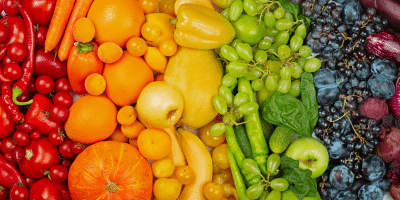Next in our Cut Your Carbon Footprint series, we explore many ways to live a more sustainable life through our food habits.
Read on for guidance on how to minimize your carbon footprint and potentially improve your health. We’ll introduce methods such as: planning meals to reduce waste, growing your own food, and transitioning toward a more plant-based diet.
What We Eat (and Don’t Eat) Matters
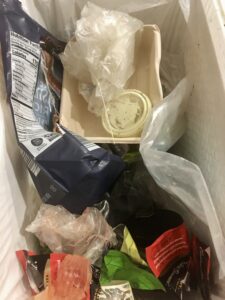
Food Trash
The most efficient step to reduce your carbon footprint is to shift your food choices. The food that comes our way is produced using a lot of resources. Food production is responsible for one-quarter of global greenhouse gas (GHG) emissions. Through your food choices there are many ways to reduce your impact and potentially improve your health.
Everything we eat has an environmental consequence. Food production includes land use, water use, water pollution, air pollution, and GHG emissions which all have an effect on the Earth. However, the degree of damage done by different foods is not equal. Meat and dairy are more resource-intensive than plant-based foods. (1). As consumers, we have the power to choose how we shop for food. Significant shifts can be made in global food systems if we collectively choose to eat and shop with the planet in mind.
What we don’t end up eating has an impact, too. Food waste is a major contributor to GHG emissions. If food waste were a country, it would be the third largest emitting country in the world (2). Tossed food is a waste of resources, money, and labor. The good news is that reducing food waste in your home can be as easy as planning your meals and storing food properly.
Join us as we incorporate methods to reduce the carbon footprint of your food choices. Learn how to shift towards a plant-based diet, plan meals to reduce food waste, shop mindfully, and more.
Going Plant-Based
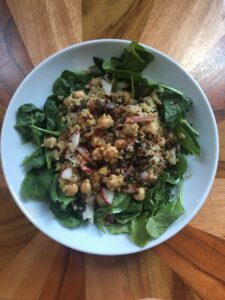
Mediterranean Chickpea Salad with Freekeh, Mushrooms, and Pistachios
People choose plant-based diets for various reasons. Common reasons include: health, ethics, environmental impact, and cost-savings. When it comes to reducing your carbon footprint, food choices present a major opportunity. Plant-based diets are associated with lower environmental impact, including fewer GHG emissions (3). Growing plant-based foods requires a smaller amount of water and land use than producing animal products. This also frees up space for forest restoration and carbon sequestration (4). It’s a win-win for the planet and your health. A strong body of research associates a plant-based diet with a variety of health benefits (5).
Moving towards a plant-based diet does not mean that you necessarily have to cut out all animal products immediately. Many people respond better to gradual dietary shifts over abrupt changes. Allow your body time to adjust. It’ll probably take some trial and error, and that’s okay. If you decide to make the shift, try committing to eating at least one plant-based meal every day and building from there. Start by cutting down on animal products and processed foods, while also stocking up on whole and healthy foods. Take time to notice how your mind and body feel as you incorporate these changes.
For plant-based recipe inspiration, check out some of the many plant-based recipes from the Yoga District blog.
Meal Planning to Reduce Waste
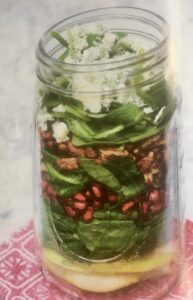
Mason Jar Salad
Meal planning can often help save time and money. It also encourages healthy eating and can reduce food waste if done right. Set aside a few hours or so once a week (or opt for twice a week) to prep and you can enjoy pre-made meals throughout the week! If you’re just starting to meal prep, then it may be helpful to begin by preparing for three days and working your way up to five.
Many of us are currently eating most if not all of our meals at home. Since we are spending more time at home this might be an excellent moment to begin meal planning. Meal planning starts with your grocery list. Assess what your week will look like and plan your grocery list accordingly.
Figure out much of a meal to make. Do you cook for others, and if yes then how often? Are you willing to eat leftovers or the same meal multiple times a week? For example, are you okay with making a specific mason jar salad and portioning it out for three lunches (6)? If the answer is yes to the above questions then you will need a larger quantity of ingredients for those meals.
Decide on the diversity of your ingredients list. Will tomatoes be the star in many of your meals? Is it easier and more cost efficient to buy one type of tomato and use it in any of the applicable meals (regardless of what a recipe instructs)? You often won’t need to prep enough food for a full week so think ahead to prevent wasting time, energy, and food. It’s useful to keep a mental inventory of your pantry and refrigerator. Note what you already have before you plan your shopping and see what you can use in the upcoming week’s meals.
Go for ingredients that are versatile enough to make into a variety of meals and snacks, and try to only buy what you know you’ll eat. While planning your meals, think beyond the recipe. Adopt the mantra: “fridge first, shop second”. Be flexible and use what’s already in your inventory before you go out to the store. Get creative! Infrequent shopping trips are another great way to decrease your carbon footprint!
For help creating custom meal plans and well-portioned shopping lists, check out Meal Prep Mate, Natural Resource Defense Council’s (NRDC) online tool for meal prepping (7).
Food Storage
“Rather than tossing food because you’re not sure if it’s still safe to eat, learn how to store food so it’ll last longer. It’s such an easy step to cut down on food waste” – NRDC sustainable food systems specialist Andrea Spacht (8).
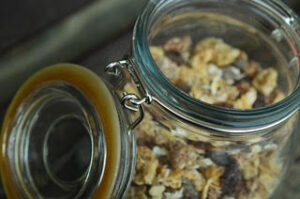 Research the optimal storage methods for your food. Learn when it’s no longer safe to eat, and make use of food before it goes bad. The terms “sell by,” “best by,” and “use by” may provide some reference point, but do not actually indicate a product’s expiration date – with the exception of baby formula (9). Understanding food safety and the difference between these terms can help reduce food waste at home.
Research the optimal storage methods for your food. Learn when it’s no longer safe to eat, and make use of food before it goes bad. The terms “sell by,” “best by,” and “use by” may provide some reference point, but do not actually indicate a product’s expiration date – with the exception of baby formula (9). Understanding food safety and the difference between these terms can help reduce food waste at home.
When it comes to food storage, freezers are your friend. If you don’t have them already, look for containers that are freezer-safe, microwave-safe, BPA-free, and pre-portioned (a bonus for meal prepping). Finding the right containers can help preserve your food longer, as well as – cut down on packaging waste. Always opt for reusable containers over single-use plastics and ziplocks.
Visit Meal Prep Mate’s sister guide for a comprehensive food storage handbook (10).
Zero-Waste Shopping
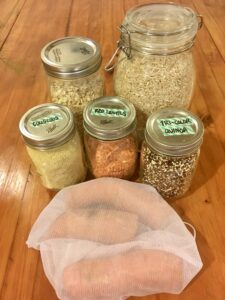
Reusable Containers
When it comes to buying food, how you shop matters. We’ve all heard that using reusable shopping bags can help reduce plastic pollution, but there are so many more opportunities to shrink your carbon footprint when you shop for food.
Avoid packaging as much as possible. Most produce can be left naked since it’s washed at home anyway. Smaller produce items can be placed in reusable produce bags or upcycled mesh bags. Bulk bins are great for reducing waste, especially with reusable containers. If you can’t find unpackaged foods then opt for paper, glass, and metal over plastic whenever possible. Try to avoid items packaged for single-use. Buying the largest container size can also maximize value and minimize the amount of packaging used. Buy the largest container of items like cooking oils, grains, beans, and nuts then store them in smaller ones. Plus, you’ll restock less often.
Farmers markets are another great way to reduce waste, especially if your local produce section looks like a sea of plastic. Shopping from local farmers also means your food won’t have to travel as far, so it’ll be fresher and more flavorful. With the bonus of fewer carbon emissions! Farmers markets often offer lower prices than conventional grocery stores, and the farmers get a better deal too, so it’s a win-win for all involved!
What you buy matters too. Like food grown locally, seasonal produce is also often fresher and more flavorful, and usually travels less. Organic produce is also often a better option for your health and the earth. Organic farming methods enhance soil and water quality, and reduce pollution compared to conventional farming (11). Studies have also shown moderate increases in nutrients and antioxidants in organic produce (12). The Environmental Working Group offers a guide for pesticides in produce based on annual analyses, called the Dirty Dozen and the Clean Fifteen (13,14). They help shoppers choose between organic and conventional produce.
Simple Urban Gardening
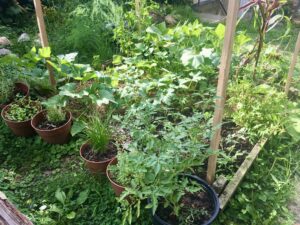
Backyard Vegetable Garden
Growing your own food may be easier than you think, and can be done with minimal resources. Even for those of us living in apartments or without a yard have many things we can grow without a garden. All you need is some organic soil and a few pots with good drainage. Start small with something you love to eat. Be mindful of different sunlight needs, and don’t overwater your plants.
As a fun, free, and sustainable option, here are some veggies that can be regrown simply from food scraps:
Green Onions, Leeks, Fennel & Spring Onions: Cut stalk from about one inch from the roots and leave them in a glass of water (without submerging the whole thing). Harvest the greens when full and repeat the process!
Celery, Cabbage, Romaine Lettuce & Bok Choy: Leave the stump in a bowl and fill the water halfway. Once there’s been new leaf growth for about a week, transfer stumps into a pot of soil. Harvest when fully grown.
Ginger: Soak the piece of ginger in water overnight. Submerge in a pot of soil and water weekly. Ready to harvest in a year.
Onion: Chop the onion bottom, leaving the roots and about 2” of the onion intact. Allow the cutting to dry for a few hours to a couple of days in a shaded, ventilated area to allow for callusing. Plant the cutting roots down, cover with 1-2” of soil and water as needed. Separate new onions and wait up to 5 months to harvest.
Garlic: Submerge garlic clove halfway and place the pot in a sunny window. Keep the soil moist and wait for the bottom ⅓ of the leaves to yellow before harvesting.
Mushroom: Remove cap and plant stalk in the soil with only the surface exposed and with minimal sunlight. If the cutting takes, you’ll see new growth quickly! Harvest and repeat.
Composting
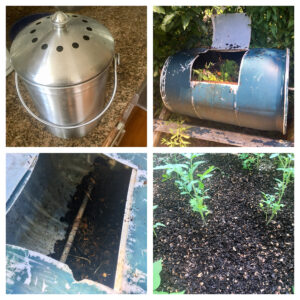
Compost Process (Inside Container -> Outdoor Bins -> Garden)
Additionally, composting your food scraps is another way to reduce food waste and can be done alongside any of the previously mentioned strategies (a bonus for gardening)! Compost is full of all kinds of microorganisms and organic material that your plants will love. Add it to your garden during the growing season, sprinkle it into flower boxes and other planters, and enrich the soil for your houseplants, and watch everything grow.
If you have outdoor space, you can start a compost pile outside. Depending on the size of your pile, reap the rewards of your homemade compost within a few months. If (like me) you don’t have space for an outdoor pile, you can still save your food scraps with indoor compost bins. These bins can be found at local hardware or garden stores and can be placed on the kitchen counter or in the freezer. I recommend ones with carbon filters to absorb any odors.
What to compost: Fruit & veggie scraps, coffee grounds & filters, tea bags, eggshells, bread, grains, rice & pasta, lint, hair & pet fur, newspaper, shredded paper, cardboard, sawdust & wood chippings, yard & garden trimmings (unless treated with pesticides)
What not to compost: Plastic, dairy, meat or fish & bones, fats, oils, or oily foods, diseased or insect-ridden plants, pet waste
If you prefer to drop off your food waste at a compost collection, the D.C. Department of Public Works (DPW) offers free food waste drop-off at a number of locations around the District (15). And, DPW also provides District residents with up to five 32-gallon bags (bring your own bags) of free compost at the Ft. Totten Transfer Station (4900 John F. McCormack Drive NE) weekdays from 1pm to 5pm, and Saturdays 8am to 3pm (16).
Visit the EPA composting web page for more tips on home composting (17).
Final Thoughts
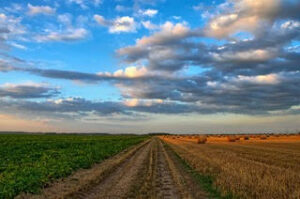 If all these actions seem intimidating, that’s okay. The goal is to move in a direction of compassion and stewardship for the planet. This means being compassionate with ourselves, too. So, you don’t have to take everything on at once.
If all these actions seem intimidating, that’s okay. The goal is to move in a direction of compassion and stewardship for the planet. This means being compassionate with ourselves, too. So, you don’t have to take everything on at once.
Have fun with these adjustments, be flexible and creative. You may find it’s not as hard as it seems to be a good steward for the environment.
Check out there rest of the Cut Your Carbon Footprint series here.
Sources
- The Environmental Impact of Food Has Huge Variability, https://www.sierraclub.org/sierra/environmental-impact-food-has-huge-variability
- Food wastage and climate change, http://www.fao.org/fileadmin/templates/nr/sustainability_pathways/docs/FWF_and_climate_change.pdf
- IPCC Report 2019, Chapter 5: Food Security, http://www.ipcc.ch/site/assets/uploads/2019/08/2f.-Chapter-5_FINAL.pdf#page=77
- IPCC Report 2019, Chapter 5: Food Security, http://www.ipcc.ch/site/assets/uploads/2019/08/2f.- Chapter-5_FINAL.pdf#page=6
- Health effects of vegan diets, https://academic.oup.com/ajcn/article/89/5/1627S/4596952
- How To Pack a Salad in a Jar, https://hurrythefoodup.com/how-to-pack-a-salad-in-a-jar/
- Meal Prep Mate, https://savethefood.com/meal-prep-mate/
- Your Newest Tool to Tackle Food Waste: Meal Prep Mate, https://www.nrdc.org/stories/your-newest-tool-tackle-food-waste-meal-prep-mate
- How to Tell Whether Expired Food Is Safe to Eat, https://www.consumerreports.org/food-safety/how-to-tell-whether-expired-food-is-safe-to-eat/
- Storage, https://savethefood.com/storage
- Organic foods: Are they safer? More nutritious?, https://www.mayoclinic.org/healthy-lifestyle/nutrition-and-healthy-eating/in-depth/organic-food/art-20043880
- Higher antioxidant and lower cadmium concentrations and lower incidence of pesticide residues in organically grown crops: a systematic literature review and meta-analyses, https://www.cambridge.org/core/journals/british-journal-of-nutrition/article/higher-antioxidant-and-lower-cadmium-concentrations-and-lower-incidence-of-pesticide-residues-in-organically-grown-crops-a-systematic-literature-review-and-metaanalyses/33F09637EAE6C4ED119E0C4BFFE2D5B1
- Dirty Dozen, https://www.ewg.org/foodnews/dirty-dozen.php
- Clean Fifteen, https://www.ewg.org/foodnews/clean-fifteen.php
- Food Waste Drop-Off, https://dpw.dc.gov/foodwastedropoff
- Fort Totten Transfer Station, https://dpw.dc.gov/service/fort-totten-transfer-station
- Composting at Home, https://www.epa.gov/recycle/composting-home

